Piero della Francesca Biography
Though little is known about Piero della Francesca and many of his works are lost forever, he was an important artist of the Italian Renaissance – he clearly formulated the geometrical rules for building perspective and made wonderful empirical discoveries in the use of color and light.
The artist was born between 1410 and 1420 in Borgo San Sepolcro near Arezzo. In the 1430s he worked in Florence under Domenico Veneziano, assisting him with the now lost fresco cycle in San Egidio (now Santa Maria Nuova). Independently he worked in his native town, and also in Rome, Ferrara, Arezzo, Rimini, Urbino, and Perugia and this played a determining role in the birth of local schools of painting.
In 1452 Piero began the wonderful cycle of frescos dealing with stories of the True Cross for the choir of the Basilica of San Francesco (Church of St. Francis) in Arezzo. The frescoes were inspired by stories from the thirteenth-century Golden Legend. The painter ignored the chronological sequence of the scenes in favor of "a structured rhythm and clear symmetry between the walls". This work demonstrates Piero’s advanced knowledge of perspective and color, his geometric orderliness and skill in pictorial construction.
In the 1450s Piero worked for the court of Rimini. Piero executed several works for the Prince of Rimini, including the fresco Sigismondo Malatesta before St. Sigismund and the Portrait of Sigismondo.
During the 1460s the artist worked for the Duke of Urbino, for whom he executed the Flagellation of Christ and the Senigallia Madonna, the wonderful twin portrait of the Duke and his wife Battista Sforza (Florence, Uffizi), the Nativity, and above all the incomparable Pala Montefeltro, which by some critics is considered to be his best work, which epitomizes the noblest aspirations of Early Renaissance.
According to Vasari, Piero lost his sight in old age and being unable to paint wrote treatises on painting and mathematics.
His mostly known pupil was Luca Signorelli (c.1445-1523).
The Legend of the True Cross:
The decoration of the choir of the Basilica di San Francesco in Arezzo, Italy, started in 1447. The work was commissioned to the Florentine painter Bicci di Lorenzo, who unfortunately died, having executed only part of the decoration. In 1452 the work was commissioned to Piero della Francesco. The theme of his frescoes – Stories about the True Cross – was inspired by the Golden Legend (Legenda Aurea), a collection of saints' legends, published in the 13th century by the Dominican Jacobus da Voragine, Archbishop of Genoa. Piero della Francesco did not follow the chronology of the story, but subordinates the separate episodes to his artistic vision of the whole composition.
The frescoes are situated in the following order:
2. Prophet, fresco by Giovanni da Piamonte
3. Prophet, possibly Jeremiah
5. Discovery and Proof of the True Cross
6. Torment of the Jew (with Giovanni da Piamonte)
7. Burial of the Wood (with Giovanni da Piamonte)
8. The Queen of Sheba in Adoration of the Wood and the Meeting of Solomon and the Queen of Sheba
9. Battle of Heraclius and Chosroes
10. Annunciation
12. Battle between Constantine and Maxentius The story itself goes in another order. It starts with Adam on his deathbed sending one of his sons, Seth, to Archangel Michael, who gives Seth a seed from the tree of the knowledge of good and evil. The seed was placed in Adam's mouth at the moment of his death. (Death of Adam. Fresco 4)
The tree that grew on Adam's grave was chopped down in King Solomon's times, but its wood could not be used for anything, so it was thrown as a bridge across a stream. The Queen of Sheba on her way to the King Solomon was about to step on the bridge, when by miracle she knew that the Savior would be crucified on a Cross of that wood. Instead of stepping on the wood she knelt and expressed her adoration. (The Queen of Sheba in Adoration of the Wood. Left part of the fresco 8). Then she hurried to Solomon to tell him about her revelation (The Meeting of Solomon and the Queen of Sheba. Right part of the fresco 8). After Solomon learnt about the divine message he understood that the wood would cause the end of the kingdom of the Jews, and ordered the bridge be removed and the wood be buried. (Burial of the Wood, fresco 7).
Centuries later Mary received the angel's message that she was chosen to give the birth to the Savior (Annunciation. Fresco 10) Solomon's precautions did not help - the wood was found and Jesus was crucified on a Cross made of it.
Three centuries later the Roman Emperors Constantine and Maxentius were struggling for power over the Roman Empire. Just before the battle of Ponte Milvio Constantine received a message in his dream that he would be given a victory if he converted and went into the battle as a Christian. (Constantine's Dream. Fresco 11) Constantine heeded the prophecy, he went into the battle holding a cross in front of himself. (Battle between Constantine and Maxentius. Fresco 12).
After Constantine's victory his mother, Helena, deeply moved by her son's conversion, decided to go to Jerusalem and find the True Cross. In the Holy City only one man, a Jew called Judas, knew the whereabouts of the Cross, but he revealed the secret only after torture (Torment of the Jew. Fresco 6). Judas brought Helena to the temple of Venus under which the three crosses of Calvary were hidden. Helena ordered the temple be destroyed and under it the three crosses were discovered (Discovery and Proof of the True Cross. Left part of the fresco 5). The True Cross miraculously resurrected a dead youth and thus it was identified (Discovery and Proof of the True Cross. Right part of the fresco 5).
Another three centuries passed and in 615 A.D. the Persian King Chosroes stole the Holy Cross, setting it up as an object of worship. The Emperor of Byzantium, Heraclius, started a war against Chosroes and defeated him in 628 A.D. at a battle on the Danube (Battle between Heraclius and Chosroes. Fresco 9). Chosroes was executed (the right corner of fresco 9) and the True Cross recaptured.
Heraclius took it to Jerusalem and carried it, barefoot, just as Christ once did; Christians hurried to meet and adore the relic (Exaltation of the Cross. Fresco 13)
Bibliography
Monumental Painting of Italian Renaissance by I. Smirnova. Moscow. 1987.
The Art of the Italian Renaissance. Architecture. Sculpture. Painting. Drawing. Könemann. 1995.
Painting of Europe. XIII-XX centuries. Encyclopedic Dictionary. Iskusstvo. 1999.
Piero Della Francesca: The Legend of the True Cross in the Church of San Francesco in Arezzo by Piero, Carlo Bertelli (Editor), Marilyn Aronberg Lavin, Maria t Donati, Anna Maria Maetzke (Editor). Skira, 2002.
Helena Augusta: The Mother of Constantine the Great and the Legend of Her Finding of the True Cross by Jan Willem Drijvers. Brill Academic Publishers, 1997.
The Piero Della Francesca Trail/the Best Picture by John Wyndham Pope-Hennessy, Aldous Huxley. Little Bookroom, 2002.
The Enigma of Piero: Piero Della Francesca by Carlo Ginzburg, Martin Ryle (Translator), Kate Soper (Translator), Peter Burke. Verso Books, 2002.
Piero Della Francesca (Art & Ideas) by Marilyn Aronberg Lavin, Piero. Phaidon Press Inc., 2002.
Piero Della Francesca by Roberto Longhi, David Tabbat (Translator), Keith Christiansen (Introduction). Sheep Meadow Pr, 2002.
Piero Della Francesca: San Francesco, Arezzo (The Great Fresco Cycles of the Renaissance) by Marilyn Aronberg Lavin, Piero. George Braziller, 1994.
Piero Della Francesca (Library of the Great Masters) by Alessandro Angelini, Lisa C. Pelletti (Translator). Scala Books, 1990.
- Sigismondo Malatesta, The Prince Of Rimini, Before St. Sigismund.
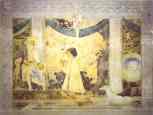
1451. Fresco. 257 x 345 cm. San Frabcesco, Tempio Malatestiano, Rimini, Italy. Read Note.
- Portrait Of Sigismondo Pandolfo Malatesta, The Prince Of Rimini.
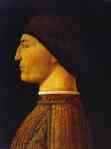
1451-1460. Mixed technique on panel. 44 x 34 cm. Louvre, Paris, France. Read Note.
- Flagellation.
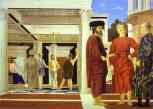
c.1470. Mixed technique on panel. 58.4 x 81.5 cm. Galleria Nazionale delle Marche, Urbino, Italy. Read Note.
- Virgin With Child Giving His Blessing And Two Angels. (The Senigallia...
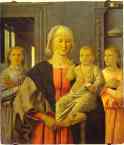
c.1470. Wood panel. Galleria Nazionale delle Marche, Urbino, Italy.
- Diptych Portraits Of Federico Da Montefeltro, Duke Of Urbino, And His...
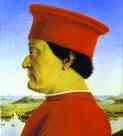
1465 - after 1472. Oil on panel. Each 47 x 33 cm. Galleria degli Uffizi, Florence, Italy. Read Note.
- Diptych Portraits Of Federico Da Montefeltro, Duke Of Urbino, And His...
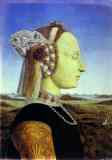
1465 - after 1472. Oil on panel. each 47 x 33 cm. Galleria degli Uffizi, Florence, Italy. Read Note.
- The Nativity.
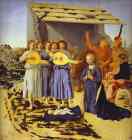
1470-85. Oil on panel. 124 x 123 cm. National Gallery, London, UK. Read Note.